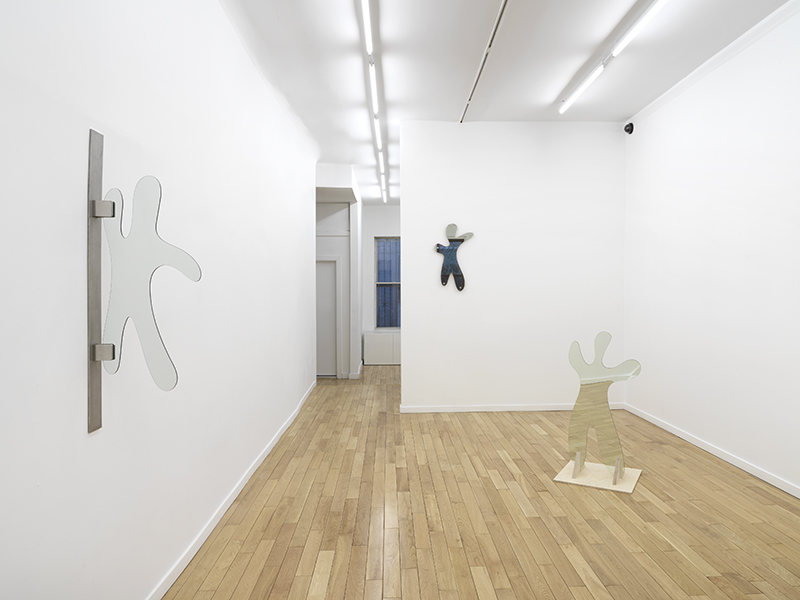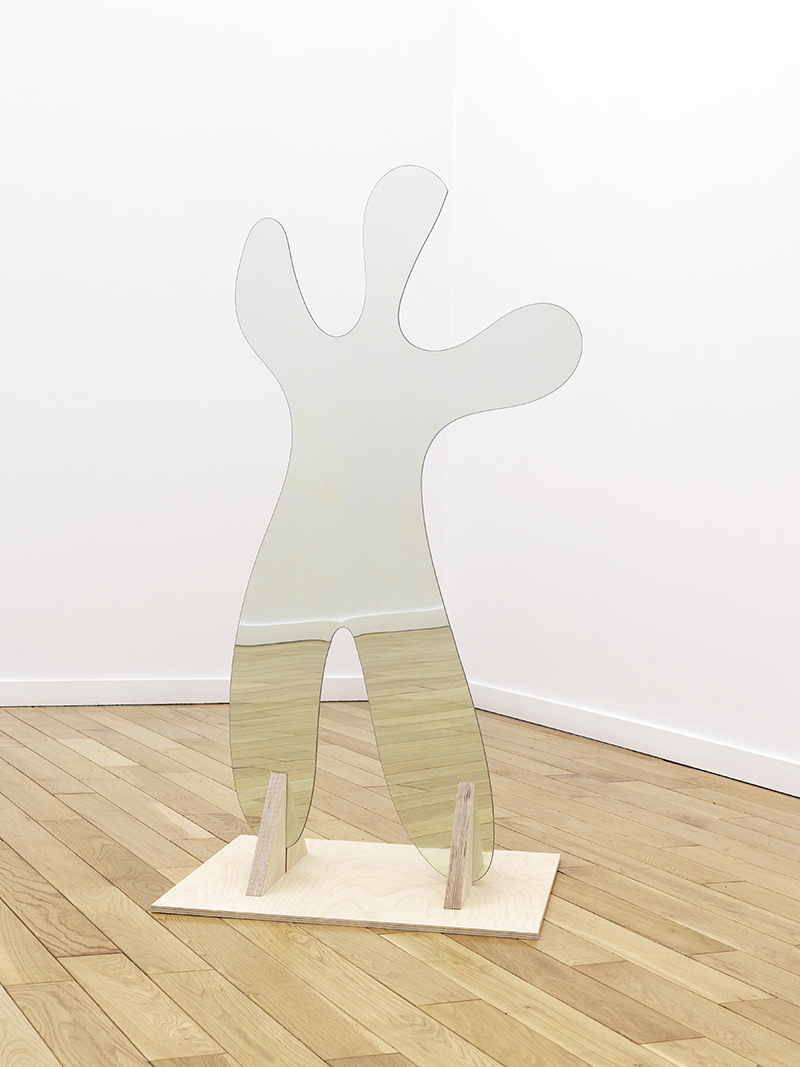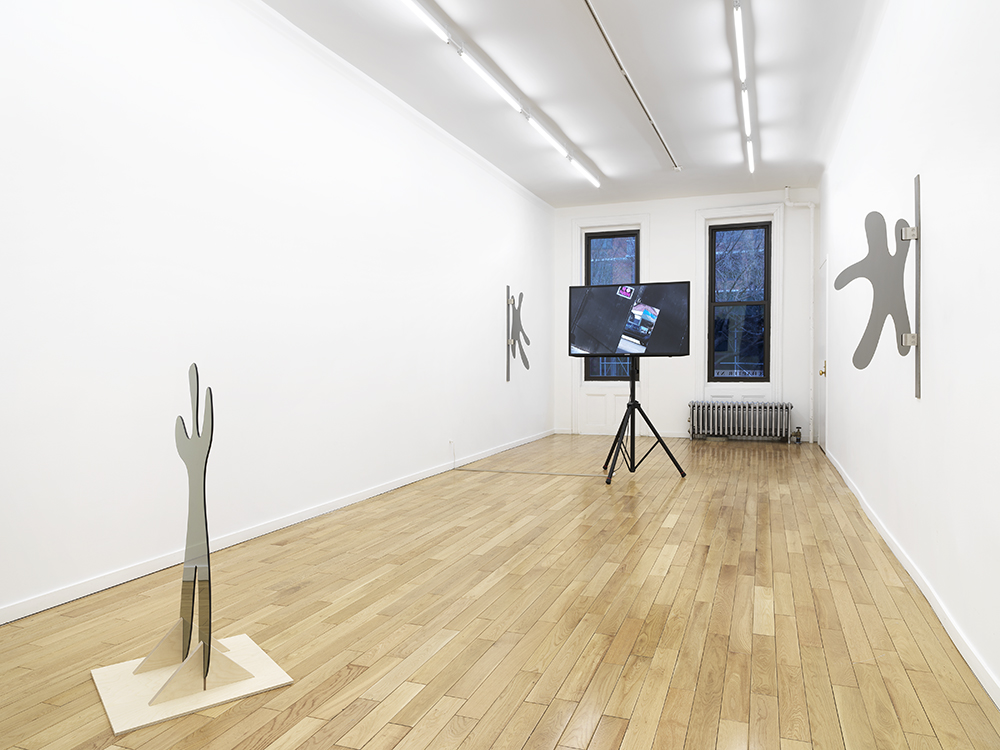Aria Dean on Conceptual One Liners and Her Least Personal Show Yet
For her second show in New York City, meta(models) or how i got my groove back, artist, writer, and curator Aria Dean created site-specific, figurative sculptures cut from mirrored glass. The self-reflective material is also featured in the exhibition’s video piece, (meta)models: “I” is a crowd (demo), wherein the camera fixates on a mirrored object on the street while three voices jokingly question its existence. Below, Dean talks through why metamodels proved useful in organizing her thoughts, her humorous approach to the materials she uses in her practice, and how she’s managed to gain enough confidence to abstract herself in her work.
Rachel Hahn: Could you tell me about how you started thinking about metamodels? A model is an abstraction of something that goes on in the real world, and a metamodel is another abstraction that kind of serves to underlie the properties of that model. How did you find that a useful framework in thinking about the structures that create blackness?
Aria Dean: I came up with the concept for the show prior to thinking about metamodels as a name or structure for what I was interested in. The mathematical model thing retroactively seemed to speak to the methods that I’m interested in for approaching blackness—approaching it structurally and abstractly rather than dealing with more material signifiers, “confronting stereotypes,” or dealing in the realm of directly representational images. I wanted to deal with the operations of blackness to better interrogate them for themselves and not rely on the layer of culture and politics so much. Whether the works in the show are actually double abstractions, as “meta models” suggests, or just a model, the idea was a useful way of thinking it through.
“(Meta)models” is also a reference to a book I read last year, a book of writings from the Ccru (Cybernetic Culture Research Unit). They used the term “metamodels” a lot, not necessarily in a way that directly tracks with the mathematical abstractions, but as a sort of mathematic thread throughout the book. Some of the stuff that was in that book ends up in the video’s dialogue, some quotes and paraphrases.

I assume that the two-way mirror was central in that? You’ve said in the past that you developed a mythos for an object or a material before you set out to make your work—like with your show in 2017, at American Medium, cotton played a big role. And then there was clay with “lonesome crowded west.” Obviously, with your most recent show at Chapter NY, the two-way mirror is kind of the object, the material, that you focus on. Can you talk a bit about how you developed the security mirror as the idea of that for the show?
All of the materials I’ve used—with clay less so—but the cotton and the security glass, both of those come out of a joke with myself. I first became interested in them in a humorous way. With the security glass, the interest initially was sort of this—you’ll probably think I’m crazy—but a cheap joke about Duboisian double-consciousness and the idea of looking and being looked at. The operations of the security glass enable that awareness of being watched by others in this way that conceptually looms large in black philosophy or black culture. Popular understandings of black subjectivity leans on that relation in a lot of ways. For all of these reasons, the security glass was, to me, funny. You know, almost like a conceptual one-liner, in a sense.

But then in actually working with it, the material kind of blossoms or comes into its own. I’m constantly searching for materials that can perform in these various directions, depending on the viewer. I’d been doing some mirror pieces previously, that were backwards vinyl wall text positioned near these antique mirrors that I would have the gallery source within the city where the show was. So, I was getting into using mirrors to implicate the audience in a particular way. As I moved toward wanting the work to be more about perception and placing the audience in a particular position in relation to given work, the glass became a really great opportunity, because it gives so little other than that. It kind of throws everything back on the viewer.
An interrogation room is the first thing that came to mind. But I was also surprised to read that our phones are two-way mirrors, which of course makes sense. You can see through it as a screen, but it’s like a mirror when you look at it when it’s off.
Yeah, I’m interested in the various meanings and perceptions that emerge like that. For instance, someone recently mentioned, “For me, focus groups are the first thing that came up with the two-way glass. Not police interrogations, but focus groups.” And the gallery is this sort of focus group situation, which I thought was really compelling.
I was wondering about visibility in terms of the mirrors, because a lot of your writing has dealt with visibility in different ways. In “Poor Meme, Rich Meme,” you’re grappling in some manner with what happens when something that was once the domain of underground black social spaces becomes highly visible, like almost becoming an end in and of itself. And then in “Closing the Loop,” you discuss representation, surveillance, and selfies, and how we’ve become subjects and objects at once. And obviously, surveillance plays a role in your show at Chapter NY with the dummy surveillance camera, and then with those two-way mirrors, which both reflect and then become transparent depending on the light. It seems like you’re kind of, again, playing with visibility and subjectivity in an even more tangible and novel way.

I hadn’t considered this show directly related to “questions of visibility as such,” but after the fact I’ve seen that visibility is still kind of this core inquiry. The entirety of my practice, from the get-go, has been about trying to figure out a relationship to visibility and being sort of caught in this paradox of being rendered invisible in certain ways but also stretched into positions of hypervisibility. And not even just particularly for black people, but just in general with surveillance culture, and with being a subject overall.
In the exhibition, I think this most comes into play with the dummy camera in the corner of the room, which doubles everything over in a way and then produces the gallery space, and the objects, and the audience also as subject-objects. The dummy camera produces the situation as “real” by, in theory, producing it as an image. Likewise, the mirrored plinth in the video that is in the show is produced as real through both being captured on film and through language. The other thing about it is that I positioned it in the classic Byzantine icon corner, referencing Kasimir Malevich’s Black Square, which I thought was a funny thing to do—and to I guess further tie the camera to its position as some external force, sort of a “god’s eye” type thing.
As you kind of touched upon, your work rebukes any personal narrative, even though you might have said that you’re trying to think about your own positionality in the world. But even with the clay in the Forward Proxy series, which comes from the earth a few hours from where your grandfather grew up in southern Mississippi, you still render it minimal and almost ahistorical in a sense. And I’m kind of curious how you’re thinking about narrative and subjectivity with the sculptures in this show.
This show is really loosened from any personal narrative. It’s not like there’s a personal narrative that I’m burying, like with the clay work, where I was trying to figure out how to do history in an exhibition without appealing to personal narrative. For that it was like, “This material has a history, but it’s not my history, but how do I relate to a history that isn’t really mine, which I’m supposed to have some relationship to.” That show was sort of negotiating my position as an artist in relation to those things.
With this show, it was the first time I was like, “You know what, I’m just going to do this the way I want to do it.” It wasn’t as reactive, I guess. I do think the questions are still there, and it goes back to the (meta)model inquiry: “I have a history. I came from somewhere. How do I negotiate that and my relationship with visibility and images?” Or let’s say “I” as just one of many black people, or just people in general. There are categorizations and characterizations to be made—things to associate myself with in order to forge a sense of “identity”—but what are the actual properties of blackness, how does it work? And parallel to this: the object, what are its actual properties? In the end the properties of it are really nothing, and I guess it’s sort of been the arc of this inquiry into blackness. This sticky un-propertied, operational force.
There are things that characterize and make up blackness, but ultimately, much like art in a way, it is this series of objects, particular things circulating, forces or whatever, but they’re all crystallized around this actual void where there’s nothing really sitting at the center. There’s no singular essence of blackness. There’s no singular essence of art.
Rachel Hahn is a Queens-based writer. She is currently on staff at Vogue, where she focuses on the intersection of music, art, and fashion.